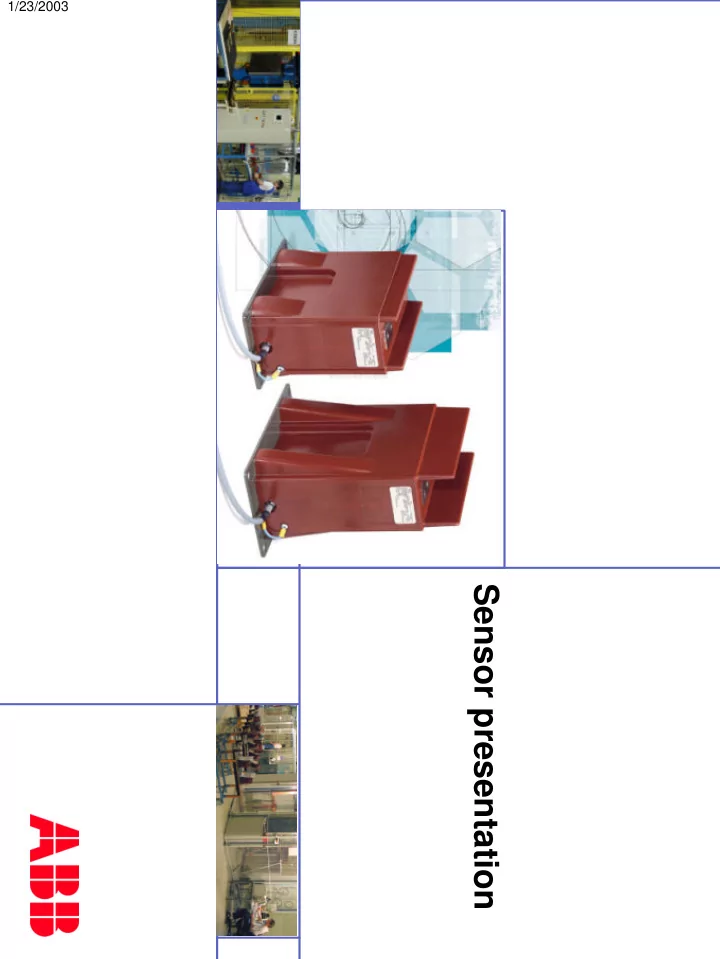

1/23/2003 Sensor presentation
Product Scope � A Sensor is a device intended to transmit a signal corresponding to the primary current or voltage to the secondary equipment. � Power IT Sensors are typically used in MV switchgears and switches for measuring, protection and indication.
Sensors vs. Instrument Transformers Trends in electrical engineering . . . but not in transformers! Size Performance Standardisation
Sensors vs. Instrument Transformers Reason: The properties of material used Saturation Unlinear range Linear range Unlinear range Remedy: Absence of iron
Why did ABB choose Rogowski coil � IEC-requirements � Cost effective Rogowski coil coil Rogowski � Low life cycle cost � Size
Rogowski coil � First published in1912 by Rogowski and Steinhous � Uniformly wound coil with non-magnetic core � Output signal is proportional to the derivate of primary current � IEC 60044-8
Why did ABB choose voltage dividers � IEC-requirements Capacitive voltage divider Capacitive voltage divider � Cost effective � Safe Resistive voltage divider Resistive voltage divider � Low life cycle cost � Size
Voltage divider Resistive divider � Matched resistor pair � 1:10 000 divider ratio � Today accuracy up to class 1 Capacitive divider � Zc = 1/ ω C � 1:10 000 divider ratio � Accuracy up to class 3 � Small size ideal for bushings IEC 60044-7
Sensors vs. Instrument Transformers Rated primary current (CT) ε I p (log) I pr = 240 A
Sensors vs. Instrument Transformers Rated primary current range (sensor) ε I p (log) I pr = 80 A....240 A.........…1250 A
Sensors vs. Instrument Transformers Accuracy limit factor (K alf ) ε c Protection class 10P CS I p (log) CT I pr
Sensors vs. Instrument Transformers Linearity Voltage error 8 6 Typical error, voltage sensor Error limit, class 3P 4 2 % 0 -2 0 50 100 150 200 250 300 -4 Typical error, voltage transformer -6 -8 U/Un %
Sensors vs. Instrument Transformers Transmitted signal level Voltage transformer (k u =1,9) Voltage sensor 1,2 - 110 V, 25 VA 12 - 1100 mV, 80 mVA Always earthed in the sensor At free potential, must be earthed Secondary losses = I 2 R Secondary losses negligible Current transformer (K alf =20) Current sensor 0,25 - 100 A, 5 VA 7,5 - 3000 mV, 6 mVA At free potential, must be earthed At free potential Secondary losses = I 2 R Secondary losses negligible High power Low power SAFE Low signal
Sensors vs. Instrument Transformers Short-circuited secondary Voltage transformer Voltage sensor 250 M Ω I sc I sc 25 k Ω I sc /A cu = 160 A/mm 2 I sc = I normal 500 ° C Temp. Explosion within 30 s
Sensors vs. Instrument Transformers Open secondary Current transformer Current sensor U open I sc 0 - 10 kV I sc /A cu = 40 mA/mm 2
Sensors vs. Instrument Transformers Frequency response ε rel CT F/Hz 10 10 1000 10 000 0 VS VS VT CS (Cap.) (Res.)
Sensors vs. Instrument Transformers Secondary wiring Terminal blocks Instr. transf. IED Wiring and screw connections Testing of connections Sensor IED Integrated cable and connector
Secondary cabling of sensors Sensor IED S1 S2
Sensors vs. Instrument Transformers Compactness Current transformer Combi Sensor Voltage transformer Small size of active parts Small size of active parts Only one core Only one core
Sensor Technology - CT/VT vs. Sensors CT / VT Sensors Signal 1/5A / 100/110 V 150mV / 2V Secondary cables Excluded Incl. and tested Linearity No Yes Saturation Yes No Ferroresonance Yes (VT) No Temperature coefficient No Incl. in accuracy EMC No Shielded Short-circuited secondary Destructive (VT) Safe Open secondary Destructive (CT) Safe Weight 40-60 kg (CT + VT) 2-25 kg (Combi) Standardisation possible No Yes
Standards for Sensors Sensors from ABB are designed, manufactured and tested according to international standards when applicable. Voltage Sensors: IEC 60044-7 (1999-12) Instrument transformers – Part 7: Electronic voltage transformers Current Sensors: IEC 60044-8 (2002-07) Instrument transformers – Part 8: Electronic current transformers Combi Sensors: IEC 60044-3 (1980-01) Instrument transformers – Part 3: Combined transformers
Sensor, type KEVCD_ � Current sensor or Combi Sensor � Measurement and protection by one sensor � Dimensions and primary connections same as DIN-type CTs (DIN 42600) � 12, 17.5, 24 kV, two types: � A. </= 1250 A � B. > 1250 A (max. 3200 A) � Including coupling electrode for voltage indication
Selection Guide for KEVCD type Sensors Rated current range (first row) Functions included (second row) Nominal voltage < 1250 A 1600...3200 A I + U + U ind I + U ind I + U + U ind I + U ind Upto 12 kV KEVCD 12 AE3 KEVCD 12 AG3 KEVCD 12 BE2 KEVCD 12 BG2 Upto 17.5 kV KEVCD 17.5 AE3 KEVCD 17.5 AG3 KEVCD 17.5 BE2 KEVCD 17.5 BG2 Upto 24 kV KEVCD 24 AE3 KEVCD 24 AG3 KEVCD 24 BE2 KEVCD 24 BG2
Technical Information in KEVCD Sensor KEVCD 12 AE3 I-sensor Ipn: 1250 A Ipr (to be advised), options: 80 A (Ir of switchgear: 80-160 A) 240 A (Ir of switchgear: 160-480 A), with adapter 640 A (Ir of switchgear: 480-1250 A), with adapter Output signal: 150 mV (50 Hz), 180 mV (60 Hz) Accuracy: Class 1* / 3 (*with correction factor) U-sensor Division ratio: 10.000/1 Accuracy: Class 1/3P Ith / Idyn: 40 kA, 3s / 100 kA Insulation level: 12/28/75 kV Frequency: 50/60 Hz With ribs on top Secondary cable (length to be advised), options: 5 m, 6.5 m or 7.5 m Primary polarity (to be advised), options: Normal or reversed Coupling electrode for voltage indication included
Sensor concept
Sensors in use around the world In use in 56 countries In use in 56 countries More than 20 000 More than 20 000 sensors in operation sensors in operation
Sensors in use around the world
Arguments for Sensors Safety Short delivery time Smart integration
Recommend
More recommend